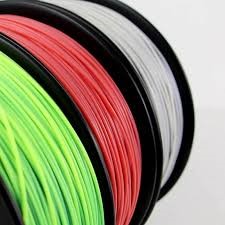ASA - Acrylo Nitrile Styrene Acrylate

Acrylo Nitrile Styrene Acrylate (ASA) is amorphous polymer belonging to the family of styrene. It can be considered a compromise between ABS and PMMA (but not transparent). The elastic component is composed of an unsaturated acrylic rubber that has no double bonds and is therefore not subject to the process of deterioration when exposed to atmospheric agents.
In fact, thanks to the replacement of butadiene with an acrylate, it improves the resilience and UV resistance (such as PMMA) combined with a good toughness in terms of impact resistence typical of ABS. Furthermore, the new grades available are capable of both keeping the color stable in time, both of requiring a reduced use of color pigments.
As a rule, the characteristics of ASA depend on the nature of the individual components: acrylonitrile ensures the hardness, the mechanical characteristics and the chemical inertia, while the acrylic rubber gives impact and UV rays resistance. From styrene, finally, are dependent the gloss, workability and surface hardness.
Due to these characteristics is chosen in outdoor applications (profiles, elements installed on roofs, parables, parts of the body industry). It requires, in addition to resistance to weathering, even a good mechanical resistance.
ASA is usually defined by three main properties:
- UV resistance;;
- Heat resistance;
- Impact resistance.
ASA can be processed by the injection or extrusion moulding process.
Typical ASA (Acrylo Nitrile Styrene Acrylate) applications are:
- Automotive: rearview mirrors and radiator grilles, bicycle and motorcycles parts;
- Electricity and Electronics: electrical panels, connectors, connector blocks, circuit breakers;
- Appliances: kitchen appliance housings, vacuum cleaner housings, control panels of white goods;
- Construction: electrical, sanitary fittings, furniture, street lamps, signs and plates.
In fact, thanks to the replacement of butadiene with an acrylate, it improves the resilience and UV resistance (such as PMMA) combined with a good toughness in terms of impact resistence typical of ABS. Furthermore, the new grades available are capable of both keeping the color stable in time, both of requiring a reduced use of color pigments.
As a rule, the characteristics of ASA depend on the nature of the individual components: acrylonitrile ensures the hardness, the mechanical characteristics and the chemical inertia, while the acrylic rubber gives impact and UV rays resistance. From styrene, finally, are dependent the gloss, workability and surface hardness.
Due to these characteristics is chosen in outdoor applications (profiles, elements installed on roofs, parables, parts of the body industry). It requires, in addition to resistance to weathering, even a good mechanical resistance.
ASA is usually defined by three main properties:
- UV resistance;;
- Heat resistance;
- Impact resistance.
ASA can be processed by the injection or extrusion moulding process.
Typical ASA (Acrylo Nitrile Styrene Acrylate) applications are:
- Automotive: rearview mirrors and radiator grilles, bicycle and motorcycles parts;
- Electricity and Electronics: electrical panels, connectors, connector blocks, circuit breakers;
- Appliances: kitchen appliance housings, vacuum cleaner housings, control panels of white goods;
- Construction: electrical, sanitary fittings, furniture, street lamps, signs and plates.



